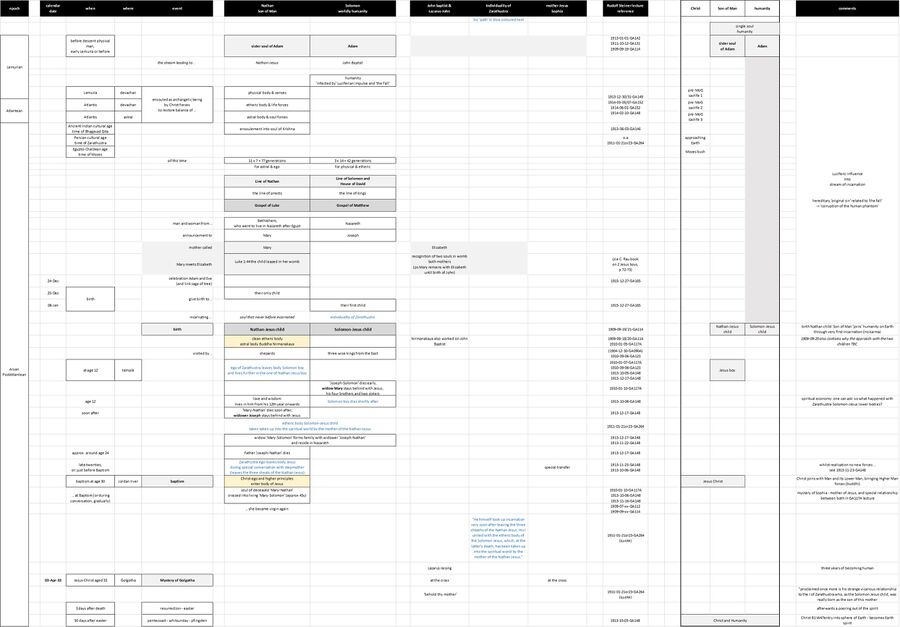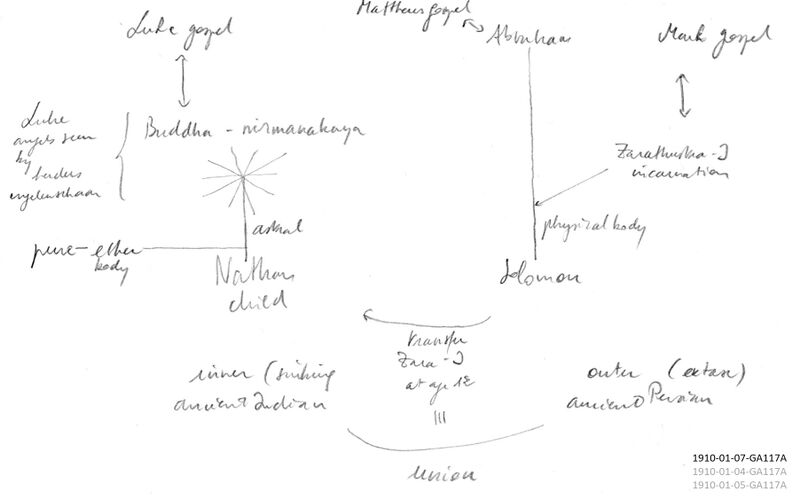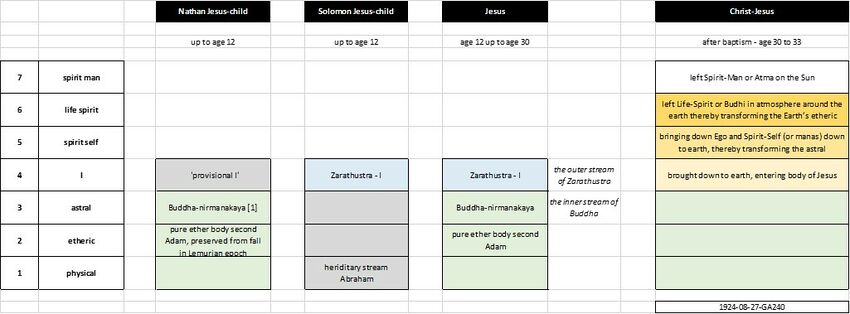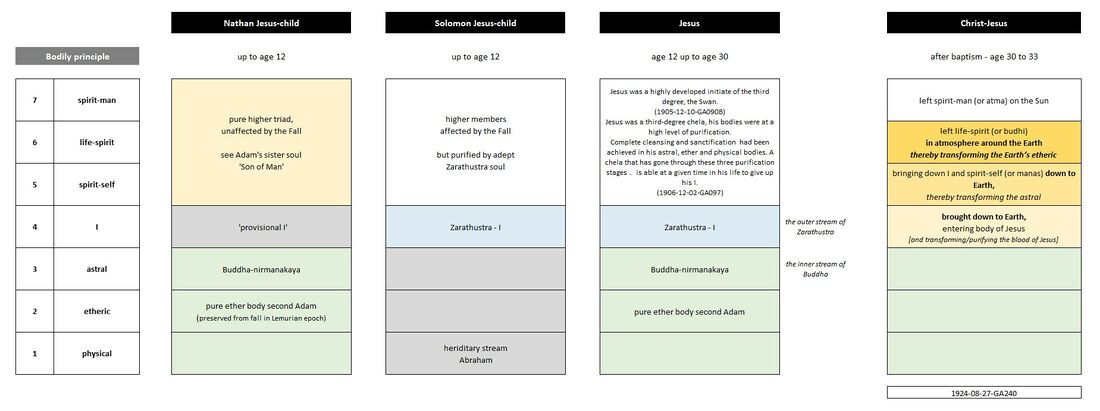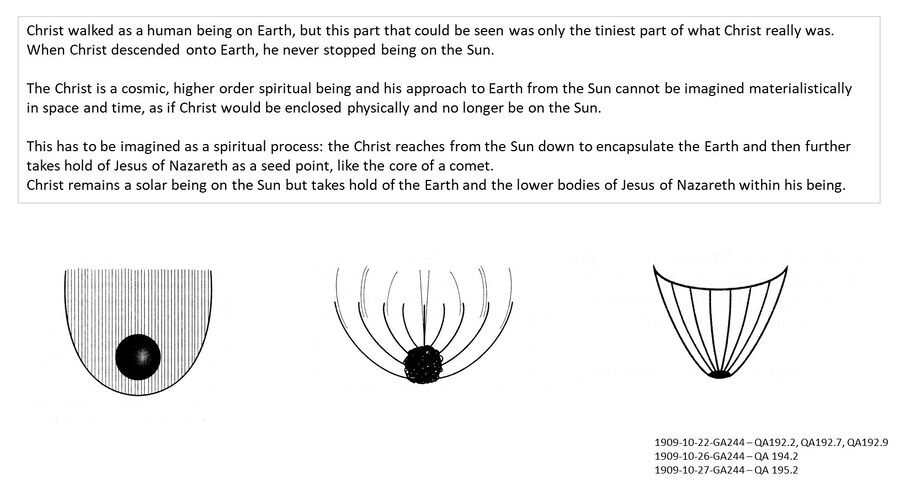The two Jesus children
The incarnation of Christ into a human being requires special preparations for the human body. The human being Jesus that became the receptacle for the Christ being was not an ordinary human at all; in fact each of the bodily structural elements of Jesus at the Baptism was prepared in special ways (see schema FMC00.043 below).
The pathway of preparation upto the Baptism is grouped under the topic of the two Jesus children, because of the two different Jesus children that were born and became one or 'merged structurally' in the temple story at age 12. Each of the two children had a different preparatory path with a different geneology, as per gospels of Luke and Matthew. Many artworks (e.g. Italian painters in the middle ages) and sources (e.g. the scrolls of the Dead Sea, see Gnosis and gnostic teachings) mention these two children, see references below for books who have grouped these sources.
The reason why this complex preparatory path was necessary (1909-09-20-GA114) is because Christ needed not just to join his spirit with the Earth, but become Man in each of Man's bodily principles down to the mineral physical body (see schema FMC00.080). This happened at age 30 for specific reasons; several aspects are to be considered together:
- the normal development of a human being and its bodily principles up to that age, and
- the requirements for a high divine being to merge into a human being
- the principles of spiritual economy, the possibilities that exist to re-use pure and advanced bodily components
Schema FMC00.080 below gives an overview of the structure of Christ-Jesus:
- The Nathan Jesus had a pure etheric body (not infected by Luciferic influences since the Fall), and an astral body infused by Buddha.
- The Solomon Jesus had the advanced I-consciousness of Zarathustra that moved into the body of the Nathan Jesus at age 12, necessary for the development upto age 30 (as laid out in Rudolf Steiner's lectures on the Fifth Gospel).
Aspects
- Nathan Jesus soul
- not an 'I' being as the rest of humanity, because no earlier incarnations and not corrupted by the Luciferic influence, so no earthly wisdom but cosmic wisdom, meaning love.
- "In the apocryphal legends it was emphasized that a direct healing force went out from him. He could tame wild animals, and spontaneous healings took place in people who were in his presence. The Nathan Jesus was a human being with completely pure life forces, with endless compassion and empathy .. someone, who purely through his presence streamed out intensive love" (Roland Van Vliet)
- the merger of the Buddha and Zarathustra streams (see below).
- the sheperds and magi at the birth of the Jesus child in the Gospels. The sheperds symbolically represent the Northern stream with a deep subconscious feeling connection to the birth of a special child, see more on: Nerthus. For context, see also Christ Impulse - meeting of two streams#Southern and Northern streams. For more on substreams, see The Michaelic stream#Substream polarities
- besides the two Jesus children, two more souls play a key role in the complete script of development - see Schema FMC00.043 and the Discussion section below.
- one was John (Lazarus-John initiated by Christ-Jesus, and the author of the Gospel of John and Book of Revelation), see Individuality of Christian Rosenkreutz and Mystery of John
- the other the mother of Jesus, see Mary topic page.
Illustrations
Schema FMC00.043 gives an overview on the two pathways for the two Jesus-children, see also FMC00.080 below. (download FMC00.043 in PDF).
The schema can be viewed on high resolution by clicking and zooming in, or downloading the JPG or PDF versions.
Schema FMC00.097 shows paintings by Da Vinci (left), Raphael's Madonna del Duca di Terranuova (middle), and a work by an unknown painter (photograph by the editor in a church in Italy).
See also: Sistine Madonna
Schema FMC00.098 shows various pictures of the scene in the temple at age 12 by Ambrogio Bergognone (left), Defedente Ferrari (middle), and a greek icon (right).
Schema FMC00.452 illustrates the two main streams in development of mankind, see also Two streams of development#1910-12-19-GA124.
The Southern stream maps to the inner path (Buddha, ancient Indian cultural age), and is the perspective of the Luke Gospel.
The Mark Gospel takes the perspective of the Northern stream and the outer path (Zarathustra, ancient Persian cultural age - but also the middle and northern European people in the first three cultural ages).
The union of the two, see also Schema FMC00.043 on The two Jesus children, is (or maps) also (to) the union of the two streams of development of humanity, see Christ Impulse - meeting of two streams, as explained in 1910-12-19-GA124 (link to relevant quote above).
See also the coverage on substreams (sheperds/magi) on The Michaelic stream - see Schema FMC00.478.
FMC00.080 gives an overview of the structure of Christ-Jesus, for the three left columns refer to schema FMC00.043.
Schema FMC00.080A is an extended version of FMC00.080 whereby information of the higher triad is added.
The Nathan Jesus child carried a 'pure' higher triad, a spiritual being and structure that also worked in the Krishna Impulse and The being of Elijah.
Schema FMC00.429: provides various versions of the drawing made by Rudolf Steiner in Q&A sessions in 1909, with a description of how to imagine Christ's 'descent' to Earth, and the working of the cosmic influence of the Christ impulse on Earth and humanity.
Though the Christ being took hold of and lived in the body of Jesus of Nazareth, his being was not physically limited to this. This is described by Rudolf Steiner in various ways, ao the structure of the Christ being on the two Jesus children (see Schema FMC00.080A), the relation between the physical body of Jesus and his working through a wider aura (see ao lectures of the fifth gospel GA148, see Schema FMC00.017), the loosening between the 'Son of Man' and the cosmic Christ (see Fleeting youth in Gospel of Mark), and finally Christ working as the spirit of the Earth.
Schema FMC00.377 sketches the link between the Adam sister soul in the three pre-MoG sacrifices of Christ (1 to 3 on the drawing) its working through Krishna (4), and the being of Elijah (5). The being of Elijah continued to work through (the nirmanakaya of) the Buddha (6) and through John the Baptist (7) also after his death (8 and 9).
In green are the well known relationships between the Adam sister soul and the Nathan Jesus, and the fact this same spiritual being was used by the Christ ensouling an archangel in the pre-MoG sacrifices. Added here is the fact the same being was behind the Krishna impulse for the refined development of the I starting with the sentient soul around the start of the Egypto-Chaldean cultural age.
In blue are other well known relationships between the being of Elijah and John the Baptist, and the further working of the being of John the Baptist (after this one's death) as the group soul of the apostles and also at the initiation of Lazarus-John (see the Mystery of John).
Connecting the blue and green (the short horizontal between Nathan Jesus and John the Baptist) are the paragraphs in 1912-09-19-GA139, see also:
- Schema FMC00.381 for a GA reference check, as the exact wordings are key
- Note [2] in the Discussion area below for a commentary
- the dark green box in Schema FMC00.377A below
Schema FMC00.377A: is an alternative presentation of Schema FMC00.377 showing various steps for the coordinated guidance of the development of the I, with the three pre-MoG interventions of the Christ, the preparatory working of the Krishna impulse and the being of Elijah, and the great enactment by Christ-Jesus and John the Baptist where the Adam sister soul worked as part of Christ-Jesus' structure and also 'from outside'.
The same colour code mapping is used for the green and blue streams as in Schema FMC00.377. The dark green box connecting John the Baptist and Nathan Jesus refers to 1912-09-19-GA139 and Schema FMC00.381.
See also related (but not yet on this schema): Wotan Impulse
Lecture coverage and references
See lecture references on Schema FMC00.043
.
1910-01-03-GA117A and 1910-01-08-GA117A
the merger of the Buddha and Zarathustra streams is discussed with a link not just to the gospels of Luke and Matthew, but also those of Mark and John. See also Schema FMC00.452
1910-09-12-GA123
"Does the higher being of Adam stay united"
Very specially prepared physical and etheric sheaths were needed to receive the descending Sun being. From our study of the Matthew Gospel we have learnt how and whence these sheaths were produced.
But from these physical and etheric sheaths derived from the forty-two generations of the Hebrew people and prepared for the Sun Being, neither the astral body nor the actual I-bearer could be directly unfolded. For this purpose a special measure was necessary, achieved through its instrumentality of a different being, namely, the Nathan Jesus, whose early history is narrated in the Luke Gospel.
Then, the Jesus of the Matthew Gospel and the Jesus of the Luke Gospel became one. The Zarathustra-Individuality, as an I, first entered into the bodily sheaths of the Jesus described in the Matthew Gospel; when this Jesus was twelve years old, the Zarathustra-I passed over into and continued to live in the Nathan Jesus of the Luke Gospel, in order, within that body, to enrich the astral body and I-bearer with the qualities attained in the specially prepared physical and etheric bodies of the Jesus of the Matthew Gospel.
The higher members in the Nathan Jesus were then able to mature and in his thirtieth year to receive the Being descending from above.
A physical body and an etheric body of this caliber could become a fitting instrument only if indwelt by the greatest Individuality - Zarathustra - who prepared mankind to understand the Christ.
This instrument could harbor the Zarathustra-Individuality for as long as it made development possible, that is to say, until the twelfth year, and the Individuality had then to pass out of the body of the Matthew-Jesus into the body of the Luke-Jesus.
The writer of the Matthew Gospel then turned his attention away from the circumstances with which he was at first concerned, to the Luke-Jesus, and followed the life of Zarathustra (in the body of that Jesus) until the thirtieth year. That was the time when Zarathustra had brought the astral body and I-bearer to the stage where he could offer up all the members in order that the Sun Spirit coming down from above might take possession. All this is indicated in the scene of the Baptism by John.
1921-09-29A-GA343
shepherds and magi
Now I must say, it was quite an inner rejoicing for me when I came across something in the Gospels which someone else probably have found as well, but I came across it through spiritual research into the Gospels. I came across an image which really should be grasped with the eyes of the soul; an image of the three Wise Men or the Three Kings — kings were in those days initiates, inspired by wisdom — how the three Wise Men according to their knowledge discovered in the stars, clearly saw the starry script in the heaven leading them to the Star of Christ, and they came to worship Christ. They actually saw that Christ had to come, according to the prophecy in the stars. For those who know out of scientific foundations what is called star wisdom, can actually only honour this image in the right sense, because they would know that star wisdom is in the most imminent sense different from what we call astronomy today. .. read further online
1973 - Oskar Kuerten
in: The earthly life of Jesus of Nazareth, quotes from 1914-02-10-GA148
That this Jesus-child was of a very special nature, however, was evident from the fact that right from birth he was able to speak, and in a language which "we could really call a primordial human language". All the languages of the world have differentiated from this primordial language through the influence of Lucifer and Ahriman:
The primordial language has been lost and cannot initially be spoken by any person today who has an I that has passed from incarnation to incarnation during the course of earthly development. This Jesus-child, who had not passed through any human incarnations, also received at the beginning of human evolution the capacity to speak a language. With a certain justification it can be said of this language that it was incomprehensible to those around him, but through the inwardness of heart that was living in it, it was understood in her heart by his mother. This points to a hugely significant phenomenon in this Luke Jesus ..
(Lecture of 10th February, 1914)
Roland Van Vliet
about the Nathan Jesus soul
extract from internet forum, to be worked still
"Steiner brings the soul of the Luke Jesus, this higher being of Adam, into connection with an angelic being. (GA152, GA180); later he even speaks of an archangelic being. (GA121, GA152) .. meaning that in this child Jesus, not the I of a human being, but an "(arch)angelic being had incarnated."
This statement correlates with Origen's (185-254 A.D.) teachings of the "one single soul which had not gone through the Fall". The soul was completely permeated by the Logos, and it had become embodied in the human being Jesus. Origen describes this human being as the "anima candida", the purified soul".
"Steiner also called this (archangelic) being however not only Apollo or Michael, but also Krishna. And Rudolf Steiner described the high archangelic being, which we, in this manner are permitted to connect with Michael, as "the sister soul of Adam". According to the presentation of Steiner, the Adam soul had incarnated into the man Jesus as presented by Luke. This sacrifice of love goes so far, that the archangelic being also here connects itself with the dragon: with the forces of death in the body. The higher soul of Adam becomes overshadowed/overlighted a fourth time: At the Baptism in Jordan. The Logos does not only overshadow/overlight the angelic being, but rather the I of the Logos incarnates in this being all the way into a union of beings. Not without a reason is Christ also described as the second or the last Adam. One could also say, that this archangelic being is of paradisiacal innocence and possesses an unspeakably great power of love that wants to transform evil."
Rudolf Steiner, writes Roland, brought this into connection with how the Greeks experienced this archangel as Apollo playing his lyre and later in the Christian tradition, St. George and St. Michael with the dragon (Apollo was in the Manichaean tradition equated with the persian god Mithras); Steiner also called this being Krishna. (GA142, GA152).
Roland writes further: "And Rudolf Steiner described the high angelic being, which we, in this manner are permitted to connect with Michael, as the "sister-soul of Adam". (GA142, GA 46). According to Steiner, the Adam soul had incarnated in the child Jesus as presented by Luke
The sacrifice of love goes so far, that the archangelic being also here connects itself with the dragon: with the forces of death in the body.
The higher soul of Adam becomes overshadowed/overlighted a fourth time [editor: after the three pre-MoG interventions of Christ]: at the Baptism in Jordan. The Logos does not only overshadow/overlight the angelic being, but rather the I of the Logos incarnates in this being all the way into a union of beings.
Not without a reason is Christ also described as the second Adam. (1 Cor 15:20-22;GA 114)
One could also say, that this archangelic being is of paradisiacal innocence and possesses an unspeakably great power of love that wants to transform evil." (From Chap.3: Buddha and Jesus).
"...In spite of their very different natures, both of the Jesus boys of about the same age became friends.
The Solomon Jesus had an astute mind and a quick comprehension and the ability to debate.
The Nathan Jesus did not have any of this. He was merely present in being and possessed a great capacity to love. He also took a deep emotional interest, so in the depths of his soul, he could have compassion for the suffering world soul. He saw in each animal, in each plant, and in each stone, a revelation of the creative spirit in nature. In the apocryphal legends it was emphasized that a direct healing force went out from him. He could tame wild animals, and spontaneous healings took place in people who were in his presence. The Nathan Jesus was a human being with completely pure life forces, with endless compassion and empathy, which did not manifest in a particular form, but someone, who purely through his presence streamed out intensive love".
(About the character of the two Jesus children: GA114-L5; GA123L6+L12; GA131-L8; 1913-10-06-GA148, 1913-12-08-GA148, 1913-12-17-GA148)
Discussion
Note 1 - The special role of John and the mother of Jesus
1. Introduction
Schema FMC00.043 shows how both John and the mother of Jesus appear as key players. There is the important relation between the souls of Nathan-Jesus and John as descendant from the stream of Adam, but the gospels contain many more touchpoints and clues, eg at the cross when Jesus gives John the mission to carry the story into the world. Similarly so for the 'mother of Jesus', see eg the book with selection of Steiner lectures 'Isis Mary Sophia' (2003).
2. A remarkable statement by Daskalos
Daskalos wrote the book 'Joshua Immanuel The Christ – His Life on Earth and His Teaching' (EN version 2001-13) in Greek and Aramaic in the last years of his life, and it contains a fragment (page 225) where he speaks of the special figures being sent for the Mystery of Golgotha besides Joshua (Jesus), and he describes as follows:
.. an archangel of the order of the principalities [editor: archai] humanized by immaculate conception .. the Virgin Mary
.. and ten years after the birth of the God-man, another archangel of the order of the principalities humanized by immaculate conception, Yiohannan, the first cousin of Joshua and his beloved companion-disciple.
Yiohannan the Baptist, also a first cousin of the God-man, was also an archangel humanized by immaculate conception from the order of the Maha-Els, the lords of the element of fire.
so he list three names besides Christ-Jesus
- [1] - the Virgin Mary,
- [2] - Yiohannan ('the first cousin of Joshua and his beloved companion-disciple'), - see coverage on Individuality of Christian Rosenkreutz for the Individuality of John
- [3] - Yiohannan the Baptist ('also a first cousin of the God-man'). - see The being of Elijah, stating also that an angelic being lived in John the Baptist (1911-02-25-GA127 and 1910-12-12-GA124)
.
Daskalos' reference to the levels of the spiritual hierarchies in this book needs to be clarified here. He uses the term archangelic order to describe any level of the various spiritual hierarchies that are the eternal creators of the seven worlds, and organized in seven groups which he gives the names we known from the seven archangels (page 124). These are mapped to the four elements, with the Maha-Els (Michaels) representing the fire element and the Kha-vir-Els (Gabriels) the water element (p 138-139 contains what Bardon describes as the tetrapolar magnet)
On page 112 is said about these holy archangelic orders, after listing the four orders of Michaels, Gabriels, Raphaels and Uriels:
.. They and others are working ceaslessly in the creation and maintenance of the materials bodies of animals and human beings .. they use their elementals, the angels, as nature spirits for their work in the vegetable kingdom. The holy archangels can, as needed, materialize a human body, and this they have done many times.
In this case the "order of the Maha-Els" appears to reference the order of Michael, as one of the seven 'rays' of the monad, across the hierarchies. Related, see also the concept of the archangelic channel on Archangel Michael (Schema FMC00.471A).
.
Now to connect to Daskalos's statement, as Rudolf Steiner put it literally in one of the thousands of lectures, see Schema FMC00.313 and more info on Three classes of Buddhas:
.. a personality who outwardly resembles a Man of our Postatlantean times, but who really is the bearer of an archai, who is ensouled by that spirit down to his physical body, is called Dhyani-Buddha.
See also FMC00.472 and variants to contemplate what this means.
The point here is that even besides Christ Jesus we are not having to do with 'ordinary human beings', but three 'accompanying' flanker spiritual beings of a higher order.
3. Mystery of John
For [3] and also [2], as well as their relationship, see the two links above, as well as Mystery of John
Indeed Rudolf Steiner's last address on 1924-09-28-GA238 contains a cryptic message regarding the relationship between John Baptist and Lazarus-John. This has been covered by various authors, oa Richard Seddon: 'The challenge of Lazarus-John', Karl König: 'The mystery of John', Sergei O. Prokofieff 'The mystery of John the Baptist and John the evangelist'. More explanations and references on Mystery of John.
4. Mary-Nathan
Regarding [1] however, the Virgin Mary, or 'Mary-Nathan' in our denomination as per Schema FMC00.043, the latter schema clearly points out to the special role she plays in the process of Christ-Jesus, which can be seen from several events:
- after the Baptism, see Schema FMC00.043, and explanations in the fifth gospel GA148: the soul of Mary-Nathan crossing into Mary-Solomon.
- Note to put the above in context. This is remarkable as we have
- a) the important conversation with Mary-Solomon (eg re Schema FMC00.017) before the Baptism in context of the fact that
- b) both Mary-Nathan and Solomon-Jesus had died after the Temple scene when the Jesus children were around age 12 (again re: FMC00.043, Rudolf Steiner does not explicitly say what happened with those souls). So Mary-Solomon was Christ-Jesus stepmother at that stage.
- Note to put the above in context. This is remarkable as we have
- before birth of John the Baptist .. what happens between Mary-Nathan and Elizabeth-John (Elizabeth, the mother of John the Baptist), coined as "recognition of the two souls in the womb of both mothers" or better put: "the mysterious influence .. exercised by the mother of the Nathan Jesus upon the mother of the Baptist .. upon John himself before he was born." (1909-09-20-GA114). See Schema FMC00.381 and Discussion Note [2] on The being of Elijah
5. Other
For further study and contextualization, see also:
- Schema FMC00.471A on Archangel Michael depicting the concept of the archangelic channel
- the Mysteries of the Father where it is made clear that the initiators were not human but divine beings
- (as already mentioned above) Schema FMC00.313 on Three classes of Buddhas, and the concept of Dhyani-Buddha
Note 2 - Schema FMC00.097: Madonnas with two Jesus children
- Da Vinci's Virgin of the Rocks shown in FMC00.097 is the original and first Paris version. The story goes the church didn't accept it and Da Vinci changed one of the children to show John Baptist, this is the London version.
- Raphael's showing of John Baptist together with the two Jesus children may have deeper meaning, given the mystery of John the Baptist and Lazarus-John (see also Mystery of John).
- Regarding the painting on the right of this Schema. The artworks are not limited to the most famous one gathered in the books below. Surprisingly the Cathedral of Santa Maria Duomo di Cortona contains the theme of two Jesus children appearing in at least three places in this old church (download PDF)
.
Note: the Madonna with two children is mostly said to be representing Jesus and John, other examples:
- Cesare da Sesto (1477-1523), considered as a painter influenced by Da Vinci, see example one
Related pages
References and further reading
- Emil Bock:
- 'Die Kindheit Jesu. Zwei apokryphe Evangelien' (1924 in DE)
- 'The childhood of Jesus : the unknown years' (1939 in DE as 'Kindheit und Jugend Jesu', 2007 in EN)
- Hella Krause-Zimmer (1919-2002):
- 'Die zwei Jesusknaben in der bildenden Kunst' (1969, 2001)
- in FR as 'Problème Des Deux Enfants Jesus' (1989)
- 'Der zwölfjährige Jesus im Tempel : das Osterfest und seine Vorstufen' (1974, lecture held 1973-04-19)
- 'Was geschah in Bethlehem?: Das Rätsel der doppelten Weihnachtsgeschichte' (2011)
- 'Die zwei Jesusknaben in der bildenden Kunst' (1969, 2001)
- Marina Wollmann: 'Im Hinblick auf den Salomonischen Jesus : eine anthroposophische Schrift' (1990)
- Daskalos: 'Joshua Immanuel The Christ – His Life on Earth and His Teaching' (EN version 2001-13)
- Edward Reaugh Smith: 'The Incredible Births of Jesus' (1998)
- David Ovason: 'The Two Children (A Study of the Two Jesus Children in Literature and Art)' (2001)
- Bernard Nesfield-Cookson: 'The Mystery of the Two Jesus Children (And the Descent of the Spirit of the Sun)' (2005)
- Gilbert Childs: 'Secrets of Esoteric Christianity: The Two Marys, the Two Families of Jesus, and the Incarnation of Christ' (2005)
- Christoph Rau: 'The Two Jesus Boys - And the Messianic Expectations of the Essenes' (original in DE 2010 as 'Die beiden Jesusknaben und die dreifache Messiaserwartung der Essener' (2010), EN in 2019 translation by Alan Stott and Michael Stott)
Unqualified: about the Dead Sea scrolls
- Esbeth Weymann: 'Zepter und Stern - Die Erwartung von zwei Messiasgestalten in den Schriftrollen von Qumran' (1993)

